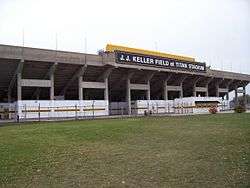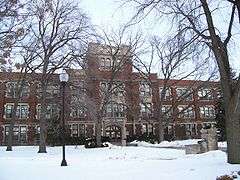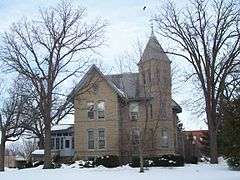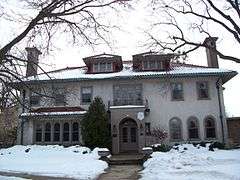University of Wisconsin–Oshkosh
 | |
| Type | State university |
|---|---|
| Established | 1871 |
| Endowment | $18.18 million[1] |
| Chancellor | Andrew Leavitt |
| Students | 13,902 (2014)[2] |
| Undergraduates | 12,623 (2014)[2] |
| Postgraduates | 945 (2014)[2] |
| Location |
Oshkosh, Wisconsin, U.S. 40°42′46″N 74°00′21″W / 40.7127837°N 74.00594130000002°WCoordinates: 40°42′46″N 74°00′21″W / 40.7127837°N 74.00594130000002°W |
| Campus | Urban, 173.5 acres (70 ha) |
| Colors |
Black, Gold |
| Nickname | Titans |
| Website |
www |
 | |
The University of Wisconsin–Oshkosh[3] (also known as UW Oshkosh) is the third-largest university in Wisconsin, United States.[4] As part of the University of Wisconsin System, UW Oshkosh offers bachelor, master, and doctoral degrees in an annual on- and off-campus enrollment of nearly 14,000. UW Oshkosh moves forward with a plan to differentiate it as a research-enhanced public university. The goal of the university is to further leverage the intellectual capital on the campus and focus on research, while also staying true to its core mission of delivering quality education.
History

In 1871 the school opened as Oshkosh State Normal School, Wisconsin's third teacher-training school. Oshkosh Normal was the first state normal school in the United States to have a kindergarten.
The university was renamed Oshkosh State Teachers College in 1927, Wisconsin State College–Oshkosh in 1951, and Wisconsin State University–Oshkosh in 1964. It became part of the University of Wisconsin System in 1971 and gained its current name.
On November 21, 1968 there were two demonstrations involved in and referred to as 'Black Thursday'. The fist demonstration occurred during the morning by mostly black students at Wisconsin State University–Oshkosh, that occupied the Presidents office, protesting against the lack of black faculty and black-oriented courses,[5] they refused to leave, damaged the Presidents office, destroyed furniture and office records. The students were arrested by baton-wielding riot police when they refused to leave.[6][7][8]
News coverage of the first demonstration was minimal unlike the National and International television and live reporting coverage of the second demonstration by 400 white students who occupied the Wisconsin State University–Oshkosh Reeves Student Union cafeteria in the early evening. Oshkosh Police contacted the President of Wisconsin State University–Oshkosh Student Assembly who entered the student union while all Oshkosh police remained outside including Oshkosh riot police standing offset around the glass floor to ceding windows of the Reeves Student Union cafeteria. The President of the Student Assembly spoke briefly to the students and convinced them to all follow him out of the student union as as he had suggested, onto the street opposite Reeves Student Unions and returned to their housing units as he also suggested, averting any arrests or violence. No students were arrested or later expelled.
Until the 1960s the Wisconsin State University–Oshkosh student body was almost exclusively white as were the Faculty. The Wisconsin State University–Oshkosh administration at the time has been described as "conservative, paternalistic" and "ruled by elderly white males in the twilight of their careers".[9] As result of the first demonstration the university expelled 94 students, almost all black, from the first 'Black Thursday' demonstration.
The first Black Thursday demonstration was marked in a campus exhibit in 2008–09. The UW-Oshkosh Library Archives hold the material from the second Black Thursday demonstration of November 21, 1968 as well as news reports and television videos.
The university has been expanding in capacity and infrastructure. Student population and campus changed little through the 1980s and 1990s. Since 2005, the institution has undertaken several green building projects and a Growth Agenda for new programs, faculty hiring and increased student population.
In 2007, the Student Recreation and Wellness Center added a student-funded facility to the university waterfront, which garnered an Innovative Architecture and Design award from Recreation Management Magazine.[10]
In 2010, the campus opened a refurbished dining hall as its new Student Success Center. The building consolidated student services into a single location. It is designed to be one of the most energy efficient buildings in the state, with a geothermal ground source heating system installed beneath a nearby parking lot.
The campus has three major buildings under construction in 2010. A new academic building (Sage Hall), the first since 1971, will house the College of Business and allied departments from the College of Letters and Science, including Psychology, Geography, and Environmental Studies. It is designed to use less than half the energy of similar buildings on campus, and to generate 10% of its energy from renewable technologies.[11] A new residence hall (Horizon Village) will replace three older buildings to provide suite-style accommodations. The building's green features include geothermal and solar technologies.[12] The third facility is the first commercial-scale dry fermentation anaerobic biodigester in the Americas, a waste-to-energy plant that will produce up to 10% of the campus electricity and heat.[13]
Recognition
UW-Oshkosh is the second-largest purchaser of renewable energy in Wisconsin, and ranks 23rd among U.S. colleges and universities in renewable energy use.[14]
UW-Oshkosh's Model United Nations program has won over 30 Outstanding Delegation awards at the National Model United Nations. [15]
Student life
Athletics
Since 2003 the men's club volleyball team has finished in the top five every year except 2008 at the National Intramural Recreational Sports Association (NIRSA) championships. In 2005, the team finished second,[16] and first in 2006,[17] 2007 and 2011.[18] The small Division 3 team won back to back to back NCVF Division 1 men's club volleyball national championships in 2014, 2015 and 2016.[19]
The baseball program appeared in 5 Division III championship games between 1985 and 1994.[20] There have been eight Titans players to play in Major League Baseball: Jim Magnuson, Dan Neumeier, Jim Gantner, Dorian "Doe" Boyland, Gary Varsho, Terry Jorgensen, Jarrod Washburn, and Jack Taschner.
In 2012, the UW Oshkosh Titans football team had its best season in program history. The Titans advanced to the NCAA Division III Semi-finals before falling to St. Thomas in St. Paul, Minnesota. The Titans finished with a 13-1 (7-0 WIAC) record and as the #4 team by d3football.com. Nate Wara was selected as a first team all-American at the quarterback position, he is the first Titan football player to achieve all-American status. Head coach Pat Cerroni was named 2012 CaptainU Coach of the Year, and was a finalist for the Liberty Mutual Coach of the Year. Assistant Head Coach John O'Grady was named the 2012 NCAA Division III Coordinator of the Year by FootballScoop.
The men's basketball program was in the NAIA Men's Basketball Championships in 1960, 1963, 1967, and 1968;[21] and the NCAA Division III Men's Basketball Championship in 1996-1998, and 2002-2003.[22]
The women's basketball program played in the NCAA Division III Women's Basketball Championship every year from 1990–1992, and again from 1994-2000. In 1995, they reached the Final Four, and the following year, won the tournament entirely.[23]
The women's gymnastics program won the AIAW Championship for Division III in 1980, the NAIA national women's gymnastics championship in 1986, and National Collegiate Gymnastics Association championships in 1989 and 2007.
The men's gymnastics program won NAIA gymnastics championships under Titans Hall of Fame coach Ken Allen in 1973, 1974, and then 5 straight years from 1978 to 1982. In addition, they won the NCAA Men's Gymnastics championship in Division II in 1980, 1981, and 1982, before the two divisions were merged in 1984.[24]
The women's track and field team has won the Division III outdoor championship in 1990, 1991, 1995, 1996, 2004, 2006, 2007, and 2011. They won the Division III indoor championship in 1994, 1996, 2004, 2005, 2006, 2011, and 2013. The Titans finished as runners-up in the 1989, 1992, 1999, 2005, 2009, 2010 and 2012 at the Division III outdoor championships, and finished as runners-up in the 1990, 1991, 1992, 2002, 2010 and 2012 at the Division III indoor championships.
The women's cross country team won the NCAA Division III Championship in 1987, 1988, 1991, and 1996, and were runners-up in 1989, 1990, and 1995.[25]
The men's track and field team won both the Division III Indoor and Outdoor Championships in 2009 and were runners-up in the NCAA Division III Indoor Track and Field meet in 1999, 2001, 2003 and 2013.
The men's cross country team won the NCAA Division III Championship in 1988, 1989, 1990, and 2002.[26]
The women's softball program went to the World Series in 1988. They also made NCAA tournament appearances in 2007 and 2008 coming up one game short of the World Series after losing the regional championship game to conference rival Wisconsin-Eau Claire. Since Cindy Suess took over the program in 2005, the Titans have won an average of 27 games per season and have yet to record a losing season.
The main on-campus sports facility is Kolf Sports Center, which contains facilities for basketball, indoor track, and volleyball. Other events held there include commencement ceremonies, concerts, and regional conventions. Both Titan Stadium (the football/soccer/outdoor track venue) and Tiedemann Field (the baseball/softball field) are located across the Fox River, 1.3 miles from campus. A recent multimillion-dollar renovation was completed with support of the Oshkosh community. The best attended sporting events at Titan Stadium are for the two Oshkosh public high school football teams that use it as their home field.
Greek life
Fraternities (As of Spring 2016) and Sororities (As of Spring 2013)
- Fraternities
- Sororities
Student media
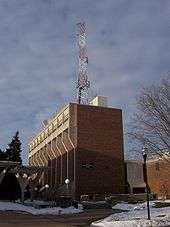
The school's newspaper is the multiple award winning Advance-Titan. The Advance-Titan is a weekly publication produced by the students at UW Oshkosh. It was founded in 1894 by students and faculty. You can read the Advance-Titan online at advancetitan.com.
The school has a radio station, WRST-FM 90.3 which is located in the Arts & Communications building. The call letters stand for "Radio Station of the Titans." The station carries Wisconsin Public Radio and student programming.
The school's student-media outlets produce young sports writing and broadcasting talent. Titan TV, the school's television channel, for a while was the only NCAA Division III school to telecast all home football and men's and women's basketball games complete with live pre-game, halftime, and post-game shows.
Historic places
Three locations on the campus have been listed on Registered Historic Places.
|
Oshkosh State Normal School Historic District | |
|
Dempsey Hall | |
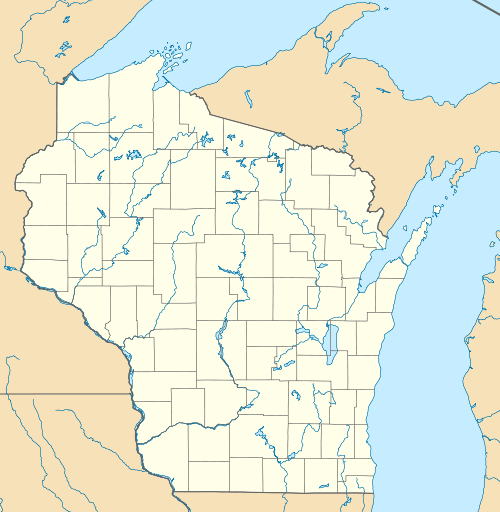  | |
| Location | Buildings at 800, 842, and 912 Algoma Blvd., and 845 Elmwood Ave., Oshkosh, Wisconsin |
|---|---|
| Area | 9 acres (3.6 ha) |
| Built | 1934 |
| Architectural style | Gothic, Other, Collegiate Gothic |
| NRHP Reference # | 84000722[27] |
| Added to NRHP | December 6, 1984 |
Oshkosh State Normal School Historic District
Three buildings on the original campus comprise this historic district. Dempsey Hall serves as the administration center of the campus. Harrington Hall hosts geology classes. Swart Hall, completed in 1928, is used by the mathematics, social work, and sociology departments and houses the Center for Economic Education. It was originally used as a lab school where student teachers taught kindergarten through ninth grade students.
 Harrington Hall
Harrington Hall Swart Hall
Swart Hall
|
Oviatt House | |
|
Oviatt House | |
| Location | 842 Algoma Blvd., Oshkosh, Wisconsin |
|---|---|
| Area | 1.2 acres (0.49 ha) |
| Built | 1883 |
| Architectural style | Late Victorian |
| NRHP Reference # | 79000121[27] |
| Added to NRHP | August 27, 1979 |
Oviatt House
Moses Hooper moved to Oshkosh in 1863, and started construction of the house in 1882. It was located at the north edge of the Wisconsin State Normal School at Oshkosh. It cost approximately $20,000 to build. Hooper moved into his new residence on October 31, 1883. The structure had modern amenities including hot water heat and running water. The interior was painted by local painters Frank Waldo and Gustav Behncke. The house was sold on September 20, 1900 to Dr. Charles W. Oviatt, a surgeon who paid $18,000 for the property. After Oviatt's death in 1912, his heirs sold the house and grounds to the State Normal School Regents in 1913 with the agreement that the heirs could live in the house until June 1914.[28]
The house was first used by the school as a women's dormitory, the first on campus. Because the dormitory operated at a loss, school president Polk discontinued the venture in 1932. After considering dismantling the building, Polk started renting the house from the school in 1934. The following three presidents of the school also resided in the house, ending with President Penson in 1989. The University of Wisconsin–Oshkosh Foundation moved its office in the house the following year.[28]
The Oviatt House was placed on the National Register of Historic Places in 1979.[28]
|
Pollock, William E., Residence | |
|
Pollock Alumni House | |
| Location | 765 Algoma Blvd., Oshkosh, Wisconsin |
|---|---|
| Area | less than one acre |
| Built | 1920 |
| Architectural style | Other, Mission/spanish Revival, Spanish-Mediterranean |
| NRHP Reference # | 84000728[27] |
| Added to NRHP | December 6, 1984 |
William E. Pollock Residence
William E. Pollock managed OshKosh B'Gosh. He had Fluor Brothers construction company build the house in 1920 for $19,000. The yard included a three-car garage, garden, and fishing pond. Pollock lived in the house from 1920 until 1937. He sold the house on a land contract, but the house was returned to him after the contract was unfulfilled. Pollock then donated the house to the Oshkosh State Teachers College in 1943.[29]
The college turned the residence into a women's dormitory which could house up to 32 co-eds. In the 1960s it was used as an honors dormitory until closing in 1967. From 1967 until 1970 it housed the College of Nursing offices. When the College of Nursing was relocated to a new building, the structure was taken over by the Alumni Association, who have occupied it since 1970. It is occasionally used for special functions.[29] Notable visitors have included President Jimmy Carter, United Nations ambassador Jeane Kirkpatrick, and Edward Albee.[29]
The house is designed as a Mediterranean Revival style house with Italian and Spanish motif. The entrance has an ornate semi-circular wrought iron door leading into a large foyer. The front entry hall opens into a large living room and a smaller parlor. A formal staircase rises to an open landing and to a study. The second story bedrooms are used as offices for Alumni and Foundation staff. The rear consists of a formal dining room, kitchen, and pantry. The building has three chimneys capped with campaniles that resemble Italian bell towers. The residence's exterior is framed by concrete planters and topped by a wrought iron balcony outside of the second floor French windows. The roof is low-pitched red-barrel tile.[29]
Notable alumni and faculty
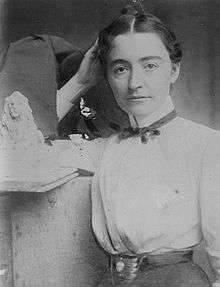 Helen Farnsworth Mears, American sculptor
Helen Farnsworth Mears, American sculptor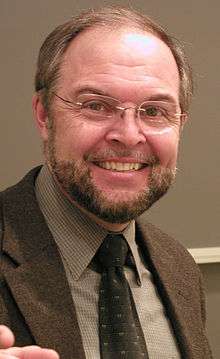 Michael Tomczyk, author & home computer pioneer (1970)
Michael Tomczyk, author & home computer pioneer (1970) P. C. Hodgell, fantasy writer, artist and current UW–Oshkosh lecturer
P. C. Hodgell, fantasy writer, artist and current UW–Oshkosh lecturer
See also
References
- ↑ As of June 30, 2015. "U.S. and Canadian Institutions Listed by Fiscal Year (FY) 2014 Endowment Market Value and Change in Endowment Market Value from FY2013 to FY2014" (PDF). National Association of College and University Business Officers and Commonfund Institute. February 27, 2015. Retrieved October 11, 2015.
- 1 2 3 "Fast Facts (2014)". University of Wisconsin Oshkosh. Retrieved 2012-02-25.
- ↑ "What is the UW System". 23 September 2015. Retrieved 13 November 2016.
- ↑ "UW Oshkosh highlights its success and prepares for the future". University of Wisconsin–Oshkosh. Retrieved 2009-05-03.
- ↑ "Blacks want to be part of university". Milwaukee Sentinel. November 23, 1968. p. 10, part 2.
- ↑ "200 patrol at Oshkosh after strife". Milwaukee Sentinel. November 22, 1968. p. 1, part 1.
- ↑ "Classes suspended, 100 held at Oshkosh". Milwaukee Journal. November 22, 1968. p. 1, part 1 part 1.
- ↑ "Oshkosh vigil backs 90 expelled students". Milwaukee Journal. January 7, 1969. p. 10, part 1.
- ↑ "Archived copy". Archived from the original on 2009-04-12. Retrieved 2009-04-12.
- ↑ Student Recreation & Wellness Center, University of Wisconsin Oshkosh; Recreation Management Magazine; retrieved December 8, 2010
- ↑ New Academic Building; University of Wisconsin Oshkosh; retrieved December 8, 2010
- ↑ New Residence Hall; University of Wisconsin Oshkosh; retrieved December 8, 2010
- ↑ Biodigester; University of Wisconsin Oshkosh; retrieved December 8, 2010
- ↑ "The University of Wisconsin Oshkosh". Retrieved 13 November 2016.
- ↑ UW Oshkosh Today » UWO Model United Nations Team earns another round of awards at national competition. Uwosh.edu (2013-04-11). Retrieved on 2013-10-05.
- ↑ "NIRSA". Retrieved 13 November 2016.
- ↑ "NIRSA". Retrieved 13 November 2016.
- ↑ "NIRSA". Retrieved 13 November 2016.
- ↑ Sharkey, Kaitlin. "UW-Oshkosh wins NCVF National Championship". WBAY-TV. Retrieved April 20, 2015.
- ↑ All-time Division III baseball champions. D3baseball.com (2012-05-27). Retrieved on 2013-10-05.
- ↑ University of Wisconsin-Oshkosh Athletics. Titans.uwosh.edu. Retrieved on 2013-10-05.
- ↑ University of Wisconsin-Oshkosh Athletics. Titans.uwosh.edu. Retrieved on 2013-10-05.
- ↑ University of Wisconsin-Oshkosh Athletics. Titans.uwosh.edu. Retrieved on 2013-10-05.
- ↑ University of Wisconsin-Oshkosh Athletics. Titans.uwosh.edu. Retrieved on 2013-10-05.
- ↑
- ↑ .
- 1 2 3 National Park Service (2010-07-09). "National Register Information System". National Register of Historic Places. National Park Service.
- 1 2 3 History of the Oviatt House; University of Wisconsin–Oshkosh; Retrieved October 26, 2007
- 1 2 3 4 History of the Pollock House; University of Wisconsin–Oshkosh; Retrieved October 29, 2007
External links
| Wikimedia Commons has media related to University of Wisconsin–Oshkosh. |
